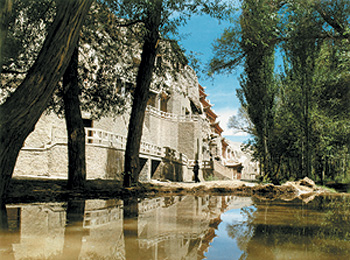
Gansu is situated in the northeast part of China. Gansu, proud of its long history, has been an important passage for cultural and trade exchange between China and western countries since the Han and Tang dynasties. Valuable cultural. Valuable cultural heritage has remained along the Silk Road. When you set your foot on Gansu, you are walkingsintosa huge museum of ancient art.
Gansu Province
Area: 390,000 sq km
Capital: Lanzhou
Neighboring Areas: Shaanxi, Sichuan, and Qinghai provinces, Inner Mongolia, Ningxia Hui and Xinjiang Uygur Autonomous Regions
Altitude: mostly above 1,000 meters
Nationalities: Han, Hui ,Tibetan, Dongxiang, Yugur, Bao'an, Mongolia, Kazak, Tu, Salar and She
Climatic Features: subtropical, humid climate in the east and temperate, dry climate in the west; cold, humid, highland climate in the Oilian Mountains; temperature shift greatly from day to night as well as from season to season in the central and western parts of the province
Average Temperature: -14C to 3C in January, 11C to 27C in July
Annual Average Rainfall: 30 - 860 mm; precipitation decreases sharply north of the 37th parallel north latitude; 50-70 percent of the rain falls during the summer
Physical Features: the Qinghai-Tibet, Loess, and Inner Mongolia Plateaus adjoin the province,swheresthe plateaus meet is a narrow, 1,000-kilometer passage, the Hexi or Gansu Corridor, which was part of the ancient Silk Road leading to the Western Regions, present-day Xinjiang and areas further to the west
Mountains: Oilian Range along the central part of the Gansu-Qinghai border; Beishan Mountains in the north; Dieshan-Minshan Mountains in the southwest
Rivers: Yellow River and tributaries, Weihe and Taohe Rivers; Bailong River in the south; Heihe, Shule and other inland rivers in the Hexi Corridor
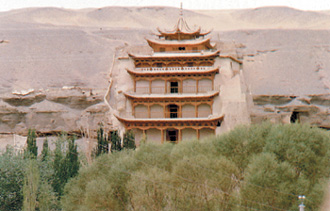
Tourist Attractions:
1.Lanzhou: the City of Lanzhou, Binglingsi Grottoes
2.Jiuquan and Dunhuang: Jiuquan: bell and Drum Tower, Jiuquan Park, Luminious Jade Cup Works
Dunghuang: Mogao Grottoes, Mingsha Mountain, Crescent Moon Spring
Jiayuguan: Jianyuguan Pass ,Mural-bearing Tombs of the Wei-Jin periods
3.Tianshui: The Maijishan Grottoes, Stome Gate( or Immortal's Cliff, Fuxi Temple, General Liguang's Tomb, Jade Spring Temple
4.Linxia and Gannan: Hongyuan Park, the Labuleng Lamasery
1.Capital: Lanzhou
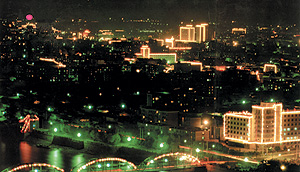
Lanzhou, anciently named Jincheng, has a history of more than 2,000 years. It is the political, conomic and cultural center of Gansu province. The city has a total area of 14,620 square kilometers and a population of 2.4336 million, with three counties and five districts under its jurisdiction. The Ye11ow River snakes its way through Lanzhou. The railway lines, such as Longhai, Baolan, Lanxin and Lanqing, intersect here. From Lanzhou, air routes extend to Beijing, Shanghai, Xi'an, Yinchuan, Baoto, Taiyuan, Xining, Urumqi, Guangzhou, Shenyang, Tibet, and to Qingyang, Jiuquan and Dunhuang inside the province. lts main industries include oil refining, chemica1s, machine building, non-ferrous metals and woolen textiles. There are many universities, including Lanzhou University, and scientific institutions in Lanzhou. Built respectively at the foot of south and north hil1s, the Five Spring Park and the White Pagoda Park stand facing each other. The city is renowned for water tobacco, honeydew melon, white lily, roses and apples produced in its suburban areas.
Binglingsi Grottoes
Binglin is a Tibetan term meaning "ten thousand Buddhas". The grottoes are on the Jishi Mountain, 50 kilometers west of Yongling County. The niches and statues are cut on steep cliffs, about two kilometers long in a four-storey honeycomb pattern. Now, about 183 caves with 694 stone sculptures, 82 clay figures and 900 square meters of murals have been preserved. The statues are all with different postures and facial expressions.
Tour to Western Part of GansuCrossing over the Wushaoling Mountain to the west of Lanzhou, one enters Gansu Corridor, the well-known passage on the Silk Road. Along the corridorswheresmany ancient cities and towns have remained, one can not only see the unique scenery of the Gobi Desert, but also the snow-capped Qilian Mountains in the sunshine. One can visit the fascinating Great Wa1l and beacon towers, enjoy the art treasure of Mogao Grottoes, the exquisite ancient buildings and the Jiayuguan Pass -- the Impregnable Pass under Heaven.
Golden Zhangye and Silver Wuwei.
Wuwei
Wuwei, once named Liangzhou, was the first town established in Hexi Corridor, through which the Silk Road extended its way westward. With convenient irrigation and developed agriculture, Wuwei is an important base producing grain, oi1, hemp and sugar beet in the corridor. Since ancient times, it has been renowned as "Silvery Wuwei".
 
 
Zhangye
Anciently named Ganzhou, Zhangye was a famous commercial port on the Silk Road and one of the biggest international trade markets in the country. Merchants from the west kept coming here for trading. Irrigation from the Black and Shandan rivers makes agriculture here quite developed. It gains the reputation of "lush southern-type fie1ds in the desert".
Jiayuguan Pass-the Impregnable Pass under Heaven
Jiayuguan pass, built in the Ming Dynasty(1372.A.D), is the western starting point of the Great Wall. With smart design and solid construction, the pass used to be a fortified military stronghold.
Jiuquan
Jiuquan, named Suzhou in ancient times, was an important commercial port and thoroughfare on the Silk Road and also a place contested by all strategists. A legend has it that "there is a golden spring in the town and the water tastes like wine". Now, Jiuquan is prospering economically and commercially. In summer and autumn, many visitors from China and abroad come here for sightseeing.
Dunhuang
Dunhuang, so named since the Han Dynasty(206B.C.-220B.C.), was a communications pivot on the Silk Road and an important center for trade and cultural exchange between China and western countries. With ferti1e land, it is rich in various products. The Mogao Grottoes lies 25 kilometers east of the town, in which art treasures such as murals and sculptures from the 4th to 14th centuries have been well preserved. To the south of the town are Mingsha Mountain and the Crescent Moon Spring, both famous scenic spots, the Yumenguan and Yangguan passes stand respectively to the north and southwest of Dunhuang.
Tour to the East
Tianshui is located in the eastern part of Gansu, on the southern bank of the Weihe River. It has enjoyed the reputation of an "electric appliance city in the northwest of China". Situated between the Yangtze and Ye1low rivers, it has a humid climate and bears the name "a tiny lush land of Southern type." The city has a 1ong history and many historical sites are dotted in its vicinity such as Grostesque Immortal's Cliff with a secluded Wood; Fuxi Temple in Tianshui built in 1506-1521A.D.; Qishan Castle in which during the Three Kingdoms Zhuge Liang , a famous strategist, stationed his Troop; Shiliandong Cave in Wushan, when it rains, one can see a curtain of running water like crystal pearls that covers the cave,swheresthere are more than 10 small halls; Kongtong Mountain, a famous Taoist mountain in history, a legend says that Huang Di, ancestor of Chinese nation once came here for learning doctrine.
Maiji Mountain Grottoes
The Maijishan Grottoes is located 45 kilometers southeast of Tianshui, in which 7,200 stone scu1ptures and clay figures from the 4th to l9th centuries have been preserved with l,300 square meters of murals. They are world-famous for their smart clay figures, which are lifelike and have rich flavour of life.
Tour to the South
A journey southward from Lanzhou leads one to Linxia Hui Autonomous Prefecture and Gannan Tibetan Autonomous Prefecture,swheresHui, Baoan, Dongxiang, Tibetan nationalities are living in compact communities. On the mountainous pasture one can see luxuriant flowers and grasses with herds of cattle and sheep rambling about like white clouds.
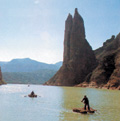 
 
The Labuleng Lamasery
The Labuleng Lamasery lies one kilometer west of Xiahe County with a total area of l,300 mu (some 87 ha.). On a grand scale and with magnificent ornamentations, it began to be built in the Qing Dynasty (l709 A.D.). It is one of the six main 1amaseries of the Ye1low Sect of Buddhism in the city, in which thousands of cultura1 relics including 60,000 volumes of Tibetan scripture havebeen well preserved.
Special Tour:
1.Bus tour from Jiuquan to Dunhuang provides opportunity to see mirages in the Gobi Desert, the Remains of Qiaowan Town, and ancient beacon towers and graves.
2.In Wushan when it rains, you can see a curtain of running water like crystal pearls that covers the cave ,where there are more than 10 small halls.
3.Huaer is a kind of folk song popular among the people in Gansu. On 28, the 4th month of lunar calendar every year, the native people gather together to take part in the annual Huaer Meet.
4.Lamasery Fair Starting on January 13, Lunar Calendar. And on January 15(lunar calendar)there is a big festival in Lamasery,swheresa grand and solemn ceremony is held annually.
Travel Tip
Hotel:
1.Fei Tian Hotel(4), Lanzhou
2.Dunhuang Sun Hotel(4), Dunhuang
3.Guanghua Hotel (3), Lanzhou
4.Jiayuguan Pass Hotel(3), Jiayuguan
Food:
Beef Noodle is a very traditional food in Lanzhou. It is made by drawing ooooout the dough by hand, and the soup is handed down from an old man who lived about 500 years ago. There are also other traditional food like Rangpizi(Cold Starchy Noodle) and some special fruits such as Lanzhou Melon.Presents:
Jiuquan has long been famous for producing jade cups which is highly praised in a popu1ar classical poem that reads "With grape wine the jade cups glow luminous at night."
Silk Carpet produced in Tianshui is also very famous for its long-history delicate crafts and arts.
Tao Ink Stone is one of super Ink Stones in China which has already had reputation since ancient time.
The above three products are very good presents for your friends not only because of their traditional craftwork and reputation ,but also because they are easy to take.
Package :
1.To Jiuquan and Dunhuang: skin cream, sunglasses, sport shoes, flashlight.
2.To Tianshui: rain gear is a must
3.A sweater, thermal underwear and other warm clothing are needed after September.
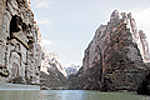 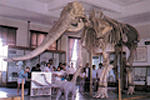
| ![]() 本网站由北京信息港提供网络支持
本网站由北京信息港提供网络支持












